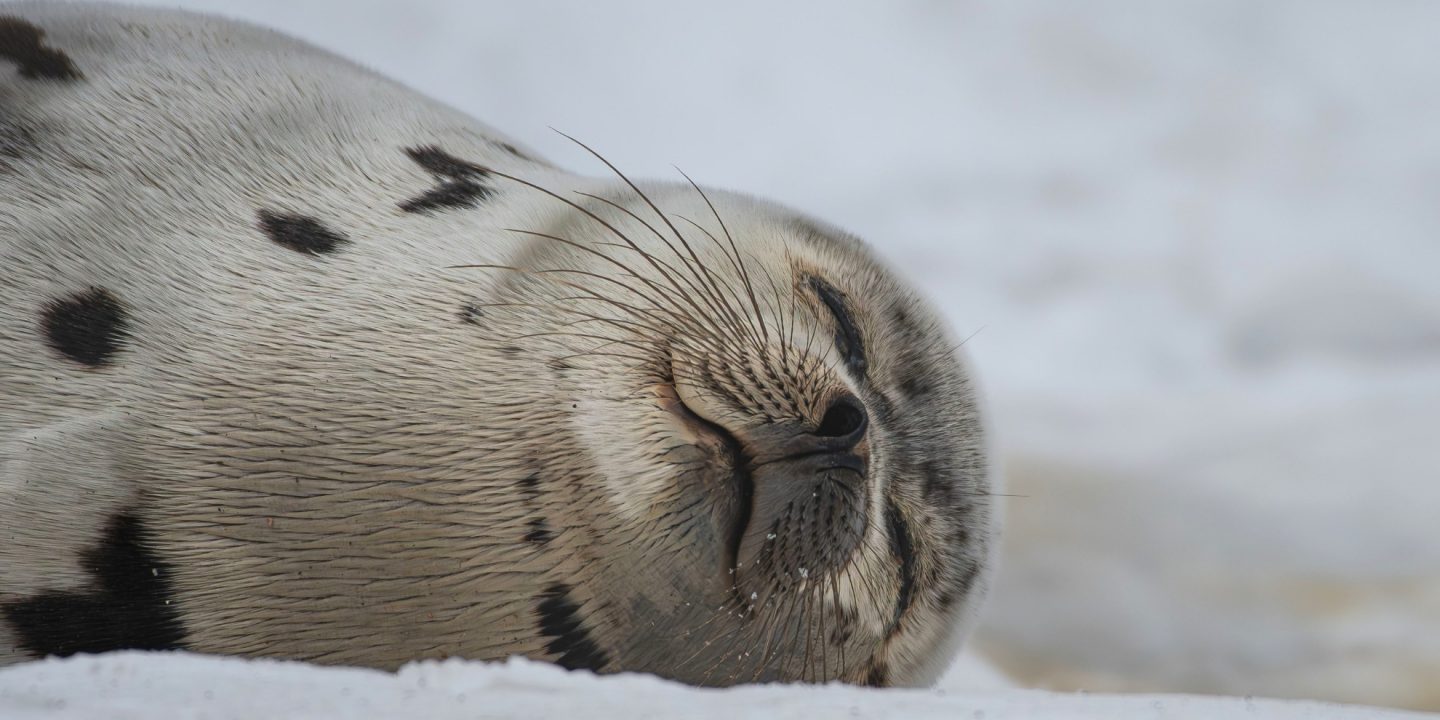Thanks to the Aquatic Conservation Initiative for providing this month’s blog.
Distribution and Population
Spread across the North Atlantic, from the Gulf of St. Lawrence, into Baffin Bay, to the Greenland Sea, all the way to the White Sea of northern Russia lives the Harp Seal (Pagophilus groenlandicus). Residing in 3 main populations – in the Greenland Sea, the White Sea, and most notably, the Northwest Atlantic – this marine mammal spends its life braving the elements in the Great White North. For Canadians lucky enough to spot a Harp Seal in the wild, they likely belong to one of three herds within the Northwest Atlantic population: the Front herd, off the East coast of Newfoundland and Labrador; the Gulf herd, near the Magdalen Islands, or the nearby smaller, northern Gulf herd. These three herds boast a combined 7.4 million individuals, and with a lifespan of up to 40 years, there is no doubt that Harp Seals are well adapted for their life on the ice.
Life Stages
To better understand this incredible species, it is best to start at the very beginning:
Winter
Abruptly thrust onto the pack ice and into frigid winter conditions as a fresh, tiny newborn – the start to a Harp Seal’s life cannot be described as a pleasant one. Rather, it is a testament to the resilience of this species – perfectly designed for the harsh Arctic conditions in which it spends most of its life.
For the first two weeks of life, the appropriately named, “White Coats” spend their days close to mom for warmth, safety, and most importantly, food. While their fluffy coat of bright white fur serves them well for both warmth and camouflage while they nurse and grow in the early weeks of life, Harp Seal pups do not look this way for long. They begin their transition to their “Beater” coat (named after the texture of this new fur), which they will sport for the next 4 to 5 weeks. During this time, mom resumes feeding, gradually weans her pup, and starts preparing herself for the fast-approaching breeding season.

Tyler, a “funny, sassy” Harp Seal who lives at the Ocean Science Centre in Logy Bay, Newfoundland. (Photo: Rachael Brown.)
Spring
Still growing, pups build their confidence by learning to swim and dive during spring. This is when they transition into the “Bedlamer” or silver coat, which is shorter, denser, and perfect for swimming in icy water. While the ice melts, these “young of the year” learn to fend for themselves, while the adults begin moving toward more productive feeding areas in the open ocean.
Summer
The Bedlamer coat will last until the pup is fully grown at 6 months old. With the arrival of summer emerges their final outfit – grey or silver (sometimes dark brown/black) fur, with the distinct “harp” marking that we all know and love. The harp not only gives this species its name, but also becomes an obvious marker for identification (each individual is unique!) in the wild. Its function for survival is debated, although it is thought to help with camouflage.
As an adult, Harp Seals in the Northwest Atlantic population spend their summers in productive offshore feeding grounds throughout the Canadian Arctic, Greenland, and off the coast of Newfoundland and Labrador.
Fall
Throughout fall, Harp Seals start to move southward once again, returning to their breeding and hauling-out areas in the Gulf of St. Lawrence and Newfoundland and Labrador. While the young of the year will not reach sexual maturity until 5-7 years of age, the older adults will continue feeding, in preparation for the energy demands of winter, whelping season, and subsequently breeding season once again.
Populations of Canada’s most endangered species have declined by more than 50 percent ↗ over the last 50 years. Add your voice for nature now by sending a personal letter to the Prime Minister, Environment Minister, Oceans Minister, and your local MP. Help protect birds and other wildlife — send the letter! ↗
In the Water
While they may not be the most graceful creatures on land, in the water, Harp Seals swim with incredible grace, fluidity, and precision. Their strong, webbed hind flippers can be opened and closed independently of one another, propelling their streamlined body through the water, executing twists and turns more eloquently than any dancer I’ve ever seen. Perhaps their most impressive talent: their ability to dive. Harp Seals can dive to depths of up to 300 metres and hold their breath for over 20 minutes when necessary! With increased oxygen storage in their blood and muscles, buoyancy assistance from their thick layer of blubber, and a talent for bradycardia (a slowed heart rate while diving – 4 to 6 BPM!) these skilled hunters can use their sensitive vibrissae (whiskers) to seek out and capture their prey with relative ease in dark waters. Cod, Capelin, Herring, Sculpin, flatfish, and small crustaceans are often no match for a hungry Harp Seal at dinner time.

Babette was a female Harp Seal who lived at the Ocean Science Centre in Logy Bay, Newfoundland and Labrador. (Photo: Rachael Brown)
Harp Seals are truly remarkable creatures, perfectly suited to their icy environment and capable of thriving in some of the harshest conditions on Earth. If you’re lucky enough to spot one in their natural habitat, it is truly a magical experience!
Want to help Canadian species like the Great Gray Owl and more? Stay tuned with the latest in Canadian nature by subscribing for email updates. You’ll receive regular updates about what we’re doing to protect Canadian nature and how you can help.
